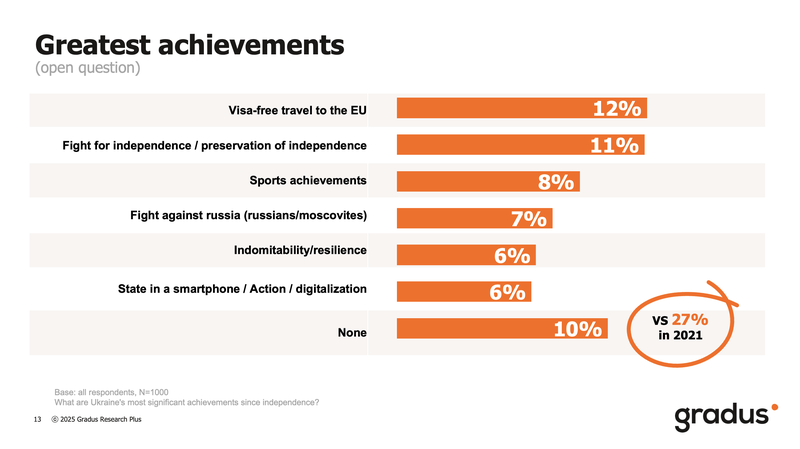Ukraine 2035: strengths, vulnerabilities, and potential

The full report is available for download via the form below.
Armed Forces, volunteering, and IT: a new Gradus study identifies the three pillars of national pride for Ukrainians in 2025
Under the pressure of a war for the country’s existence and independence, Ukrainians have become more aware of national achievements and priorities. According to the results of the Gradus study “Ukraine 2035: Strength, Vulnerability and National Potential,” conducted in November 2025, an overwhelming majority across all age groups (75%) take pride in the Armed Forces of Ukraine. Volunteering and civic engagement rank second (55%), with digital technologies in third place (42%). Meanwhile, the share of those who see no achievements of the state has almost tripled down compared to 2021, the pre-war year.
Contribution to development and Independence
Respondents most frequently named these three areas — the Armed Forces (80%), volunteers (76%), and the IT sector (71%) — as key drivers of Ukraine’s development throughout the years of Independence. High scores were also given to the agricultural sector (62%), social cohesion (57%), and the defence industry (54%). By contrast, the weakest contribution is associated with law enforcement and the judicial system (63% distrust), as well as public administration and institutional capacity.

A similar pattern appears when assessing the potential for strengthening resilience and development through 2035. The Armed Forces again top the ranking with 80%, followed by IT and digital technologies with 75%. Third place (69%) is shared by the agricultural sector and food security, volunteering and civic engagement, and the defence industry.
Shifts in the perception of achievements
The survey highlights how the war has clarified national identity and prompted a reassessment of real accomplishments. In 2021, 27% of respondents could not name any major achievement of Ukraine. In 2025, this dropped to 10%, signalling a higher perceived value of statehood. The most frequently mentioned concrete achievements were the EU visa-free regime (12%) and the preservation of independence (11%).

Future outlook: Ukraine 2035
Looking ahead to the next decade, Ukrainians place their hopes on MilitaryTech, IT, and the agricultural sector. They see Ukraine’s global role as a “shield of Europe” — a zone of active investment, though with partially limited agency.

In the open-ended responses, the fields with the greatest development potential included the defence industry, IT and digitalisation, the agricultural sector and food security, the army, construction, and energy.
Overall, most respondents envision a positive future for Ukraine. Words such as peaceful, flourishing, free, optimistic, and bright appeared in 47% of positive open-ended responses. Only 16% described the future in negative terms such as difficult, declining, or nonexistent.
The conflict between paternalism and individual responsibility
Comparing responses across 2021, the first year of the full-scale invasion, and late 2025 shows an increasing share of people who place responsibility for their well-being on the state. At the same time, when it comes to state interference in personal life and balancing private and public interests, Ukrainians continue to lean toward individualism and personal freedom.
“The results reveal an interesting tension in the worldview of Ukrainians in 2025. On the one hand, there is a growing demand for paternalism — we expect security and well-being from the state. On the other, Ukrainians remain convinced individualists who view personal freedom and non-interference as absolute values. The balance between these two vectors will shape the social contract for the next decade,” says Evgeniya Blyznyuk, sociologist, CEO and founder of Gradus.
The full report is available for download via the form below.
The study was conducted by Gradus Research using a self-administered questionnaire in the Gradus mobile application. The sample reflects the population structure of cities with more than 50,000 residents aged 18–60 by gender, age, settlement size, and region, excluding temporarily occupied territories and areas of active hostilities. Fieldwork period: 7–10 November 2025. Sample size: 1,000 respondents.
Other reports
-
 Digital ethnography of Ukrainians 2025November 2025What does everyday life look like for Ukrainians in 2025?
Digital ethnography of Ukrainians 2025November 2025What does everyday life look like for Ukrainians in 2025? -
 Ukraine 2035: strengths, vulnerabilities, and potentialNovember 2025Special survey for the 10th Deloitte Ukraine “Conductors of Change” Forum
Ukraine 2035: strengths, vulnerabilities, and potentialNovember 2025Special survey for the 10th Deloitte Ukraine “Conductors of Change” Forum -
 Research on media consumption in UkraineNovember 2025Media Consumption Under the Microscope: Ukrainians Spend More Time in Messengers Than in Front of the TV
Research on media consumption in UkraineNovember 2025Media Consumption Under the Microscope: Ukrainians Spend More Time in Messengers Than in Front of the TV -
 How has the war changed Ukrainians' eating habits?October 2025Special survey for the New Food Summit 2025
How has the war changed Ukrainians' eating habits?October 2025Special survey for the New Food Summit 2025





